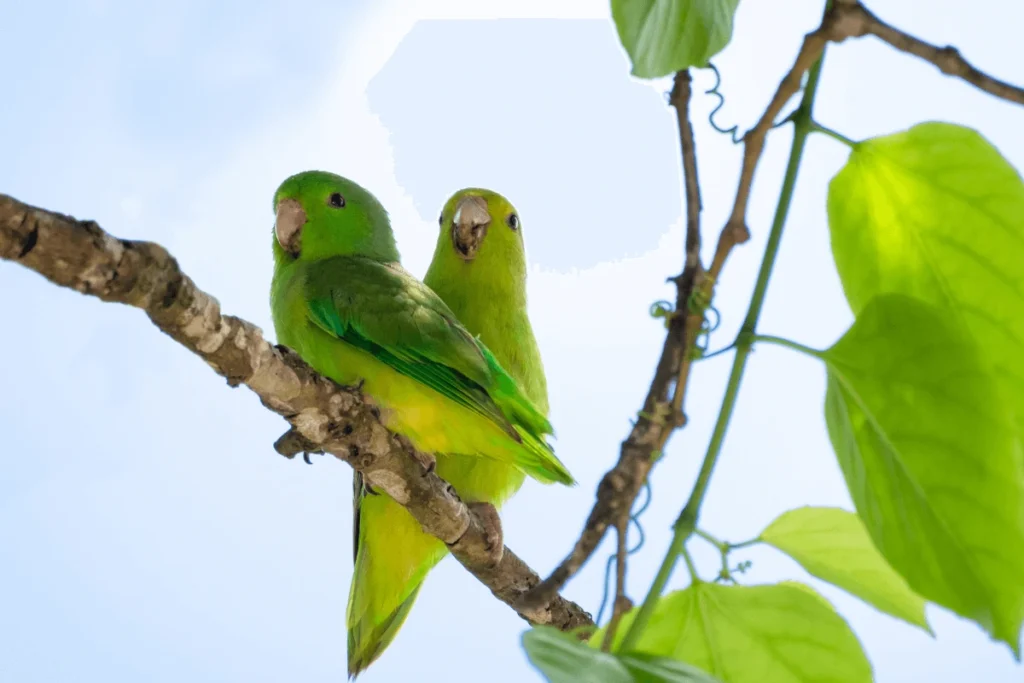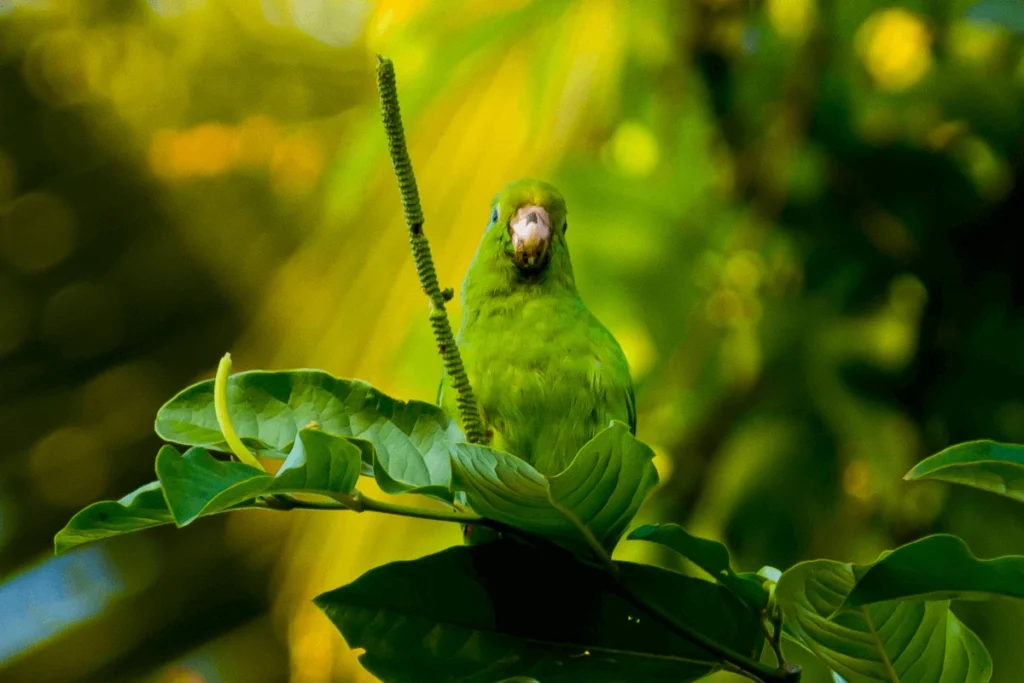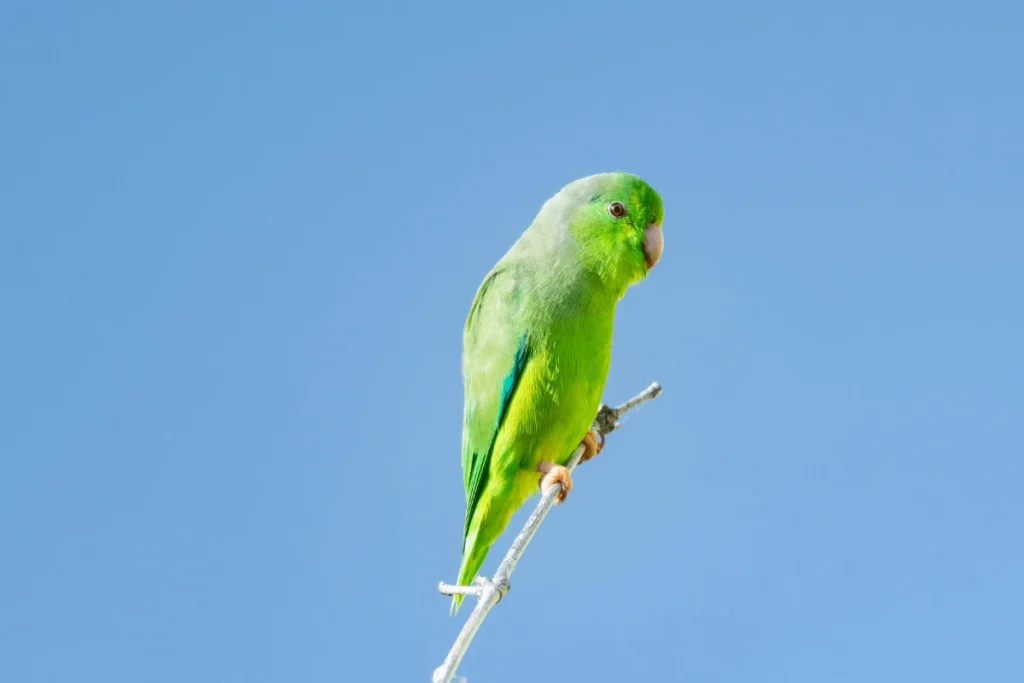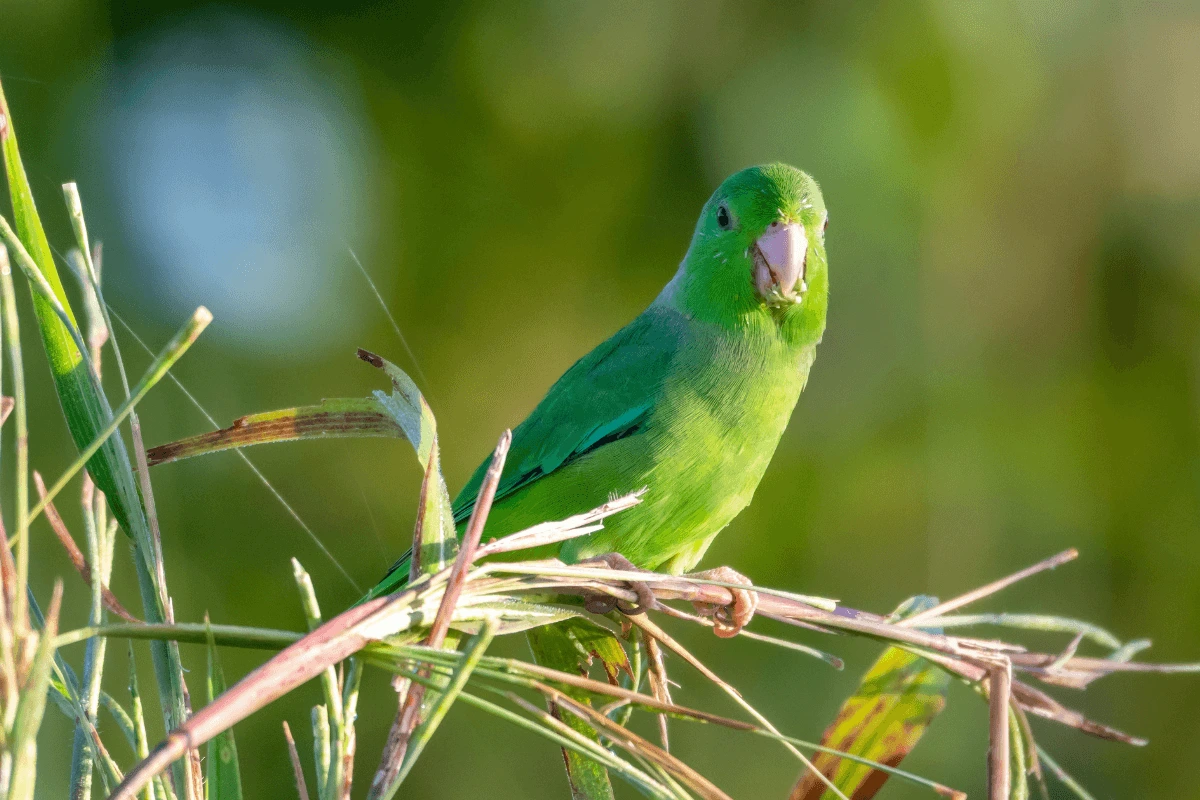The Tepui Parrotlet (Nannopsittaca panychlora) is one of the most fascinating and rare South American parrots. This tiny bird thrives in the isolated, high-altitude forests of Venezuela and Guyana, making it a hidden gem of the avian world. Unlike more common parrot species, the Tepui Parrotlet remains elusive due to its remote habitat and small population.
This rare parrot belongs to the Psittacidae family and stands out for its vibrant green feathers, energetic personality, and strong social bonds. It may be small, but it plays a vital role in its ecosystem by helping to disperse seeds and maintain the delicate balance of its forest home. However, threats like habitat destruction and climate change put this species at risk, making conservation efforts essential.
In this article, you’ll discover ten heartwarming facts about the Tepui Parrotlet, from its incredible adaptability to its charming behaviors. Whether you’re a bird enthusiast or just curious about rare wildlife, this tiny parrot’s story will leave you amazed.
Tepui Parrotlet: A Tiny Treasure Among Parrots
One of the Smallest Parrot Breeds
The Tepui Parrotlet is one of the smallest parrot breeds, measuring just 11 cm (4.3 inches) in length and weighing only a few grams. Despite its tiny size, this bird is full of energy and personality. Unlike larger parrot species, which are more commonly recognized, the Tepui Parrotlet remains relatively unknown due to its remote habitat in South America. Its small size allows it to navigate the dense foliage of cloud forests, flitting quickly between branches in search of food.
Birdwatchers who spot this elusive species describe it as incredibly agile. It can hover briefly like a hummingbird and maneuver effortlessly through tight spaces between leaves. While it may not have the talking abilities of larger parrots, its lively chirps and social calls make up for it. The Tepui Parrotlet communicates constantly with its flockmates, reinforcing strong social bonds that help them survive in the wild.
The Tepui Parrotlet’s small stature gives it an advantage when avoiding predators. Larger birds of prey may overlook this tiny parrot, especially since its green plumage blends perfectly with the dense forest canopy. Its miniature size also makes it less likely to be hunted or captured for the pet trade, unlike some other exotic parrots. However, its population remains vulnerable due to environmental threats.
Even though it may not be as famous as some of its brightly colored relatives, the Tepui Parrotlet is a remarkable bird that proves size does not determine importance in the natural world.
Vibrant Green Plumage for Camouflage of the Tepui Parrotlet
The Tepui Parrotlet’s striking green feathers are more than just beautiful—they serve as a natural camouflage that protects it from predators. This bird’s plumage blends perfectly with the moss-covered trees and thick foliage of the Venezuelan tepuis, making it nearly invisible among the leaves. Unlike some other South American parrots that have bright reds, blues, or yellows, the Tepui Parrotlet relies on its subtle green hues to stay hidden.
In the dim, misty environments of high-altitude forests, this camouflage is essential for survival. Predators, such as hawks and snakes, struggle to spot the parrotlet as it moves swiftly through the dense canopy. When it remains still, even the keenest eyes have difficulty distinguishing it from the surrounding vegetation.
This adaptive coloring also helps the Tepui Parrotlet during its foraging activities. As it searches for seeds, fruits, and nectar, it can move undetected, avoiding unnecessary threats. Even when feeding in small groups, their synchronized movements and muted colors make them difficult to track.
Juvenile Tepui Parrotlets often have slightly duller feathers compared to adults, further improving their ability to remain unnoticed in the forest. As they mature, their feathers develop a slightly more vibrant green, indicating their readiness to take on adult responsibilities within the flock.
Although their coloring helps them evade danger, their survival still depends on the conservation of their habitat. If deforestation continues, their natural camouflage will no longer be effective, as they will have fewer trees to hide in.
A Bird of the Sky-High Cloud Forests
Thrives in Remote Tepui Parrotlet Mountains
The Tepui Parrotlet calls some of the most remote and mysterious places on Earth home. The Venezuelan tepuis—massive, flat-topped mountains—rise above the surrounding rainforest, creating isolated ecosystems unlike any other. These towering formations, often called “islands in the sky,” support unique wildlife that cannot be found anywhere else.

Living in these rugged landscapes has allowed the Tepui Parrotlet to avoid many of the dangers that threaten lowland bird species. However, this isolation also makes the species difficult to study. Scientists and birdwatchers must embark on challenging expeditions to catch even a brief glimpse of this tiny parrot. Many tepuis remain largely unexplored, leaving much about the Tepui Parrotlet’s habits and population size unknown.
Despite its small size, the Tepui Parrotlet has adapted well to life at high altitudes. It thrives in the misty, wind-swept conditions of cloud forests, where temperatures are cooler than in the tropical lowlands. Its tiny body and lightweight frame allow it to navigate through dense vegetation, making it well-suited for life in the treetops.
The tepuis serve as a natural fortress, protecting the Tepui Parrotlet from human interference for centuries. However, with increasing deforestation and climate change, even these isolated refuges face growing threats. As conservationists work to protect these vital ecosystems, the Tepui Parrotlet’s continued survival depends on preserving these towering landscapes.
Tepui Parrotlet Survives in Misty, High-Altitude Forests
The Tepui Parrotlet thrives in high-altitude cloud forests, where mist and rain create a cool, humid environment. These forests, found at elevations of 1,200 to 2,200 meters (3,900 to 7,200 feet), are home to an incredible variety of plants and animals, many of which are not found anywhere else.
The constant cloud cover in these forests creates a moist environment that supports an abundance of mosses, ferns, and orchids. These plants provide shelter and food sources for the Tepui Parrotlet, allowing it to find everything it needs to survive. The thick vegetation offers protection from predators, giving the tiny parrot plenty of hiding spots as it moves through the treetops.
Unlike parrots that live in drier climates, the Tepui Parrotlet has adapted to the cool, damp conditions of its home. It roosts in small tree cavities or dense foliage at night, keeping warm by staying close to other flock members. During the day, it stays active, using its agility to navigate the dense network of branches and vines.
The Tepui Parrotlet’s survival is closely linked to the health of these high-altitude forests. Deforestation, mining, and climate change threaten this delicate ecosystem, reducing the availability of food and nesting sites. As temperatures rise, cloud forests may start to disappear, forcing the Tepui Parrotlet to move higher in search of suitable habitats.
Protecting these forests is crucial not only for the Tepui Parrotlet but also for countless other species that depend on these misty mountain environments.
A Unique and Varied Diet
Feeding on Seeds and Fruits
The Tepui Parrotlet has a highly adaptable diet that allows it to survive in the remote cloud forests of South America. Seeds and fruits make up the bulk of its diet, providing essential nutrients and energy. Unlike larger parrots that rely heavily on nuts, this rare parrot species prefers softer seeds and small fruits found in the treetops.
The Tepui Parrotlet plays a crucial role as a seed disperser, helping to regenerate the forest. As it eats, it spreads seeds throughout the environment, ensuring the growth of new trees and plants. Without birds like the Tepui Parrotlet, many tree species in the Venezuelan tepuis would struggle to reproduce.
During the rainy season, when food is more abundant, the Tepui Parrotlet thrives on a wide variety of fruits. It carefully selects ripe berries, figs, and other tropical fruits, using its sharp beak to break them open. These small parrots often forage in small flocks, chirping and communicating as they search for food.
However, during dry periods, food becomes scarcer, and the Tepui Parrotlet must adapt. It may fly longer distances to find fruiting trees, relying on its strong navigation skills to locate new feeding grounds. If deforestation continues to reduce the number of fruit-bearing trees, the survival of the Tepui Parrotlet could become increasingly difficult.
Drinking Nectar from Flowers
Unlike many other South American parrots, the Tepui Parrotlet has an unusual dietary habit—it drinks nectar from flowers. This behavior is more commonly associated with hummingbirds, but the Tepui Parrotlet has developed a similar feeding strategy. By inserting its beak into the center of flowers, it extracts the sweet nectar hidden inside.
This feeding habit makes the Tepui Parrotlet an important pollinator in the cloud forests. As it moves from flower to flower, it helps transfer pollen, enabling plants to reproduce. This symbiotic relationship benefits both the birds and the plant species they rely on. Without the Tepui Parrotlet and other nectar-feeding birds, many tropical flowers would struggle to reproduce.
Because nectar provides a quick source of energy, the Tepui Parrotlet often drinks it early in the morning before searching for more substantial food sources like seeds and fruits. This high-energy food helps fuel its fast-paced lifestyle, keeping it active and alert throughout the day.
However, changes in the environment, such as deforestation and climate change, could impact the availability of nectar-producing plants. If the flowers the Tepui Parrotlet depends on disappear, this rare parrot species could face food shortages, making conservation of its habitat even more critical.
Conservation Challenges for This Rare Bird
Threats from Habitat Destruction
The biggest threat facing the Tepui Parrotlet is habitat destruction. Although its home in the Venezuelan tepuis has remained relatively untouched for centuries, human activity is beginning to impact these once-pristine environments.
Logging, mining, and land development are reducing the number of suitable nesting and feeding sites for this rare parrot species. As trees are cleared, the Tepui Parrotlet loses the shelter and food sources it needs to survive. Unlike some birds that can adapt to new environments, this parrot is highly specialized, relying on the unique conditions of high-altitude forests to thrive.

Illegal deforestation is also a growing concern. While the Tepui Parrotlet does not have a high market value in the pet trade like some other exotic parrots, the destruction of its environment affects its entire ecosystem. If deforestation continues, this Neotropical bird may face increasing challenges in finding safe nesting sites.
To prevent further decline, conservationists are pushing for stronger protection of the Tepui Parrotlet’s habitat. Expanding nature reserves and enforcing stricter environmental policies could help safeguard this species from the dangers of habitat loss.
Climate Change Impacting Their Ecosystem
Climate change is another significant threat to the Tepui Parrotlet. Since this bird thrives in cool, misty cloud forests, any shift in climate patterns could have devastating effects on its survival.
As global temperatures rise, cloud forests are becoming drier and warmer. This change reduces the availability of food, forcing the Tepui Parrotlet to move to higher elevations in search of cooler, more suitable conditions. However, these birds are already living at high altitudes, meaning there are limited places left for them to go.
Another major concern is the impact of climate change on flowering plants. Since the Tepui Parrotlet relies on nectar as part of its diet, changes in plant blooming cycles could disrupt its food supply. If flowers start blooming at different times or become less abundant, the parrot could struggle to find enough nutrition.
Conservationists are urging governments and environmental organizations to prioritize the protection of cloud forests and limit deforestation, which contributes to climate instability. By preserving these ecosystems, we can help ensure that the Tepui Parrotlet continues to thrive in its natural environment.
Why This Parrot Needs More Recognition
Tepui Parrotlet: Rarely Seen in Captivity
The Tepui Parrotlet is almost never seen in captivity, making it one of the most elusive rare parrot species in the world. Unlike macaws, cockatoos, or budgerigars, which are common in the pet trade, the Tepui Parrotlet remains almost entirely in the wild. Its remote habitat in the Venezuelan tepuis and specialized diet make it unsuitable for life in captivity.
Parrots that thrive as pets typically adapt well to human environments, eat a variety of foods, and breed easily under controlled conditions. However, the Tepui Parrotlet depends on the unique resources of its cloud forest home. It feeds on specific seeds, fruits, and nectar that are difficult to replicate in captivity. These dietary needs make it challenging to care for outside of its natural habitat.

Another reason the Tepui Parrotlet remains absent from aviculture is its secretive nature. This smallest parrot breed prefers to live high in the treetops, avoiding human contact. While some parrots form strong bonds with people, the Tepui Parrotlet thrives in the wild, foraging with its flock and navigating the dense Amazon rainforest canopy.
Though this species does not face immediate threats from illegal pet trafficking, it still requires protection. Many South American parrots suffer due to habitat destruction and climate change. The best way to appreciate the Tepui Parrotlet is by supporting conservation efforts that protect its natural environment rather than attempting to bring it into captivity.
Tepui Parrotlet is a Part of the Neotropical Birds Family
The Tepui Parrotlet belongs to the Psittacidae family, which includes some of the most colorful and intelligent birds on the planet. As part of the Neotropical birds group, this species shares its classification with many well-known parrots from South America, such as macaws, Amazons, and conures. However, unlike its more famous relatives, the Tepui Parrotlet remains one of the least-studied members of this diverse bird family.
Neotropical birds are native to Central and South America, thriving in environments ranging from tropical rainforests to mountainous cloud forests. The Tepui Parrotlet specifically inhabits the high-altitude forests of Venezuela and Guyana, a region known for its biodiversity and unique wildlife. These cloud forests provide the perfect environment for the Tepui Parrotlet, offering plenty of food sources and nesting sites high in the canopy.
Unlike larger parrots, which may live in pairs or small family groups, the Tepui Parrotlet often forms small flocks. These birds communicate through soft calls and are highly social within their group. While many Neotropical birds are known for their loud vocalizations, the Tepui Parrotlet tends to be quieter, blending into its forested surroundings.
Being part of the Neotropical birds family means that the Tepui Parrotlet plays an essential role in its ecosystem. Like other South American parrots, it helps disperse seeds and pollinate flowers, contributing to the health of the Amazon rainforest and cloud forests. Understanding its place in the Psittacidae family highlights the need for conservation, ensuring that this unique species continues to thrive in its natural habitat.
Importance of Parrot Conservation
Conserving parrots like the Tepui Parrotlet is essential for maintaining healthy ecosystems. Parrots are more than just beautiful birds; they play a direct role in seed dispersal, forest regeneration, and biodiversity preservation. As the Tepui Parrotlet eats fruits and seeds, it spreads plant life throughout the Venezuelan tepuis, helping new trees and vegetation grow.
Unfortunately, many South American parrots face serious threats, including habitat loss, illegal wildlife trade, and climate change. While the Tepui Parrotlet is not widely captured for the pet trade, deforestation and human activity continue to threaten its home. Logging, agriculture, and land development are reducing the number of trees available for nesting and food, forcing these birds to compete for limited resources.
Conservation efforts must focus on protecting the natural habitats of rare parrot species like the Tepui Parrotlet. Preserving cloud forests and ensuring that protected areas remain undisturbed can help secure the future of these birds. Organizations working to protect Neotropical birds emphasize the need for environmental policies that prevent excessive deforestation and promote sustainable land use.
Supporting parrot conservation means protecting entire ecosystems. When conservationists safeguard the Tepui Parrotlet’s habitat, they also protect countless other species that depend on the same environment. Ecotourism, responsible wildlife observation, and habitat restoration projects can make a difference in ensuring that future generations can still witness the beauty of South America’s rare parrot species in the wild.
Conclusion
The Tepui Parrotlet may be small, but it plays a vital role in its ecosystem. As a seed disperser and pollinator, this tiny parrot helps maintain the biodiversity of high-altitude cloud forests in South America. Without it, many plant species would struggle to reproduce, affecting the entire forest ecosystem.
Despite its ecological importance, this Parrotlet remains one of the least-known South American parrots. Its remote habitat in the Venezuelan tepuis makes it difficult to study, and few people outside of conservation circles are even aware of its existence. Unlike other exotic parrots, it is not part of the pet trade, which has helped protect it from illegal capture. However, habitat destruction and climate change continue to pose serious threats to its survival.
Protecting this rare parrot species means preserving its cloud forest habitat. Conservation efforts should focus on preventing deforestation, enforcing environmental protections, and promoting sustainable ecotourism. The more people learn about the Tepui Parrotlet, the more support conservation initiatives can receive.
Although it may not be as famous as macaws or cockatoos, this little bird is just as important. By working to protect its home, we help safeguard one of the world’s most unique ecosystems. Every effort counts, whether it’s raising awareness, supporting conservation programs, or advocating for responsible environmental policies. The Tepui Parrotlet’s survival depends on what we do today.
Discover the Top 10 Small Parrots for New Owners Here.
Discover The Purple Parrot Birds From Here.
Read About Other Pets and breeds From HERE!
Find Out the Best stuff for your Pet On Pet MD Official.

1 thought on “Tepui Parrotlet: Top 10 Heartwarming Facts About This Rare Bird”
Comments are closed.